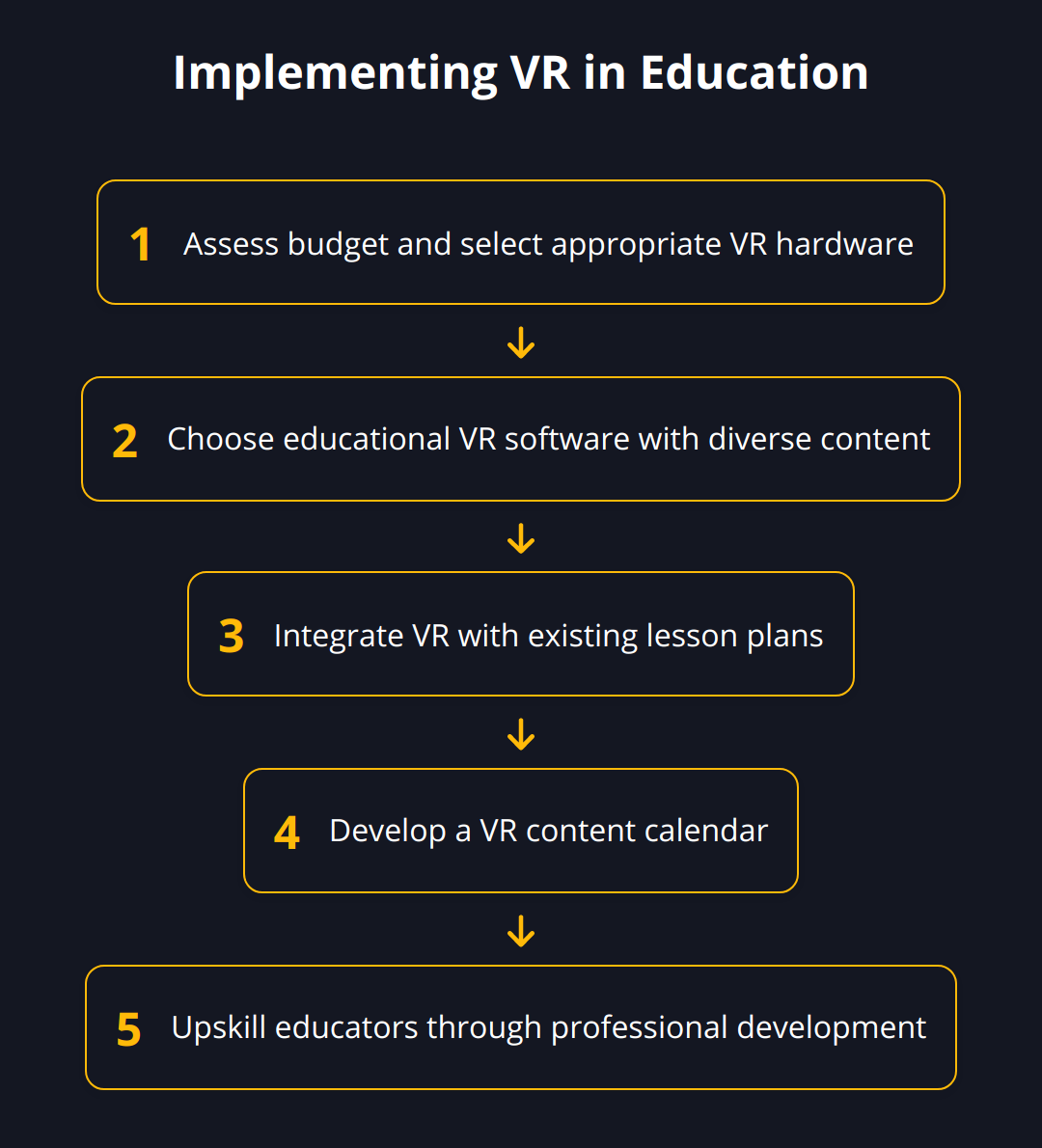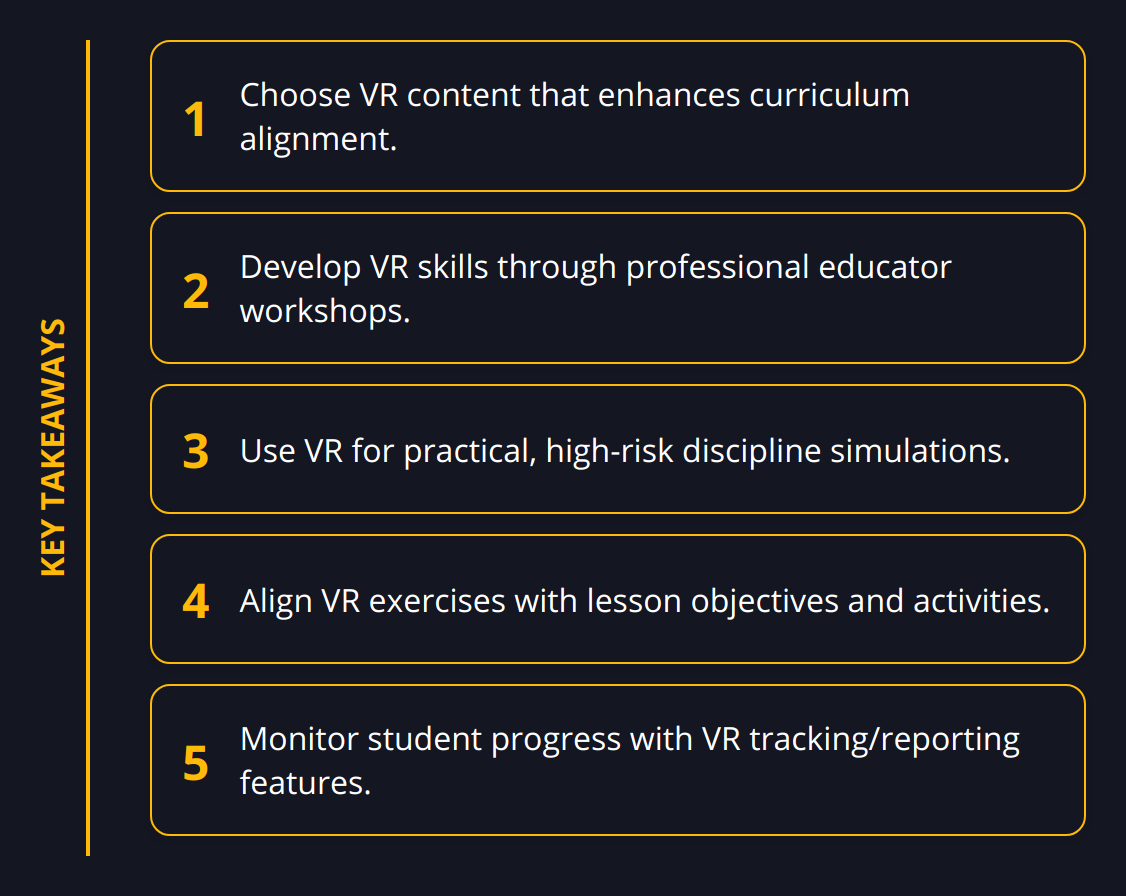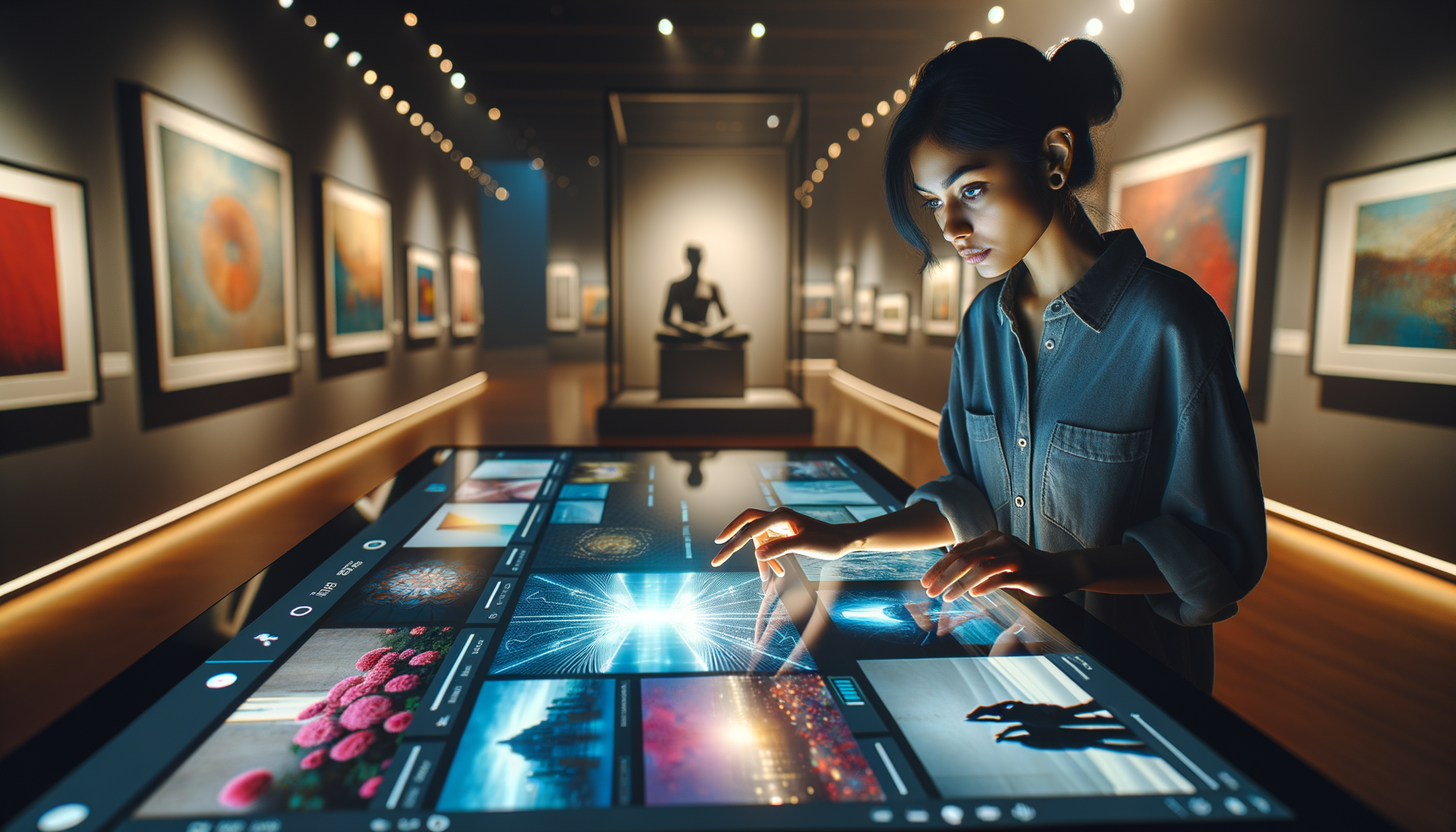We at Newroom Connect believe that the evolving landscape of education calls for cutting-edge tools, and virtual reality (VR) offers an unparalleled opportunity for immersive learning. By transporting students to virtually constructed environments, VR can transform traditional classroom dynamics and cater to various learning preferences.
The advent of VR technology in educational settings presents both exciting opportunities and practical considerations. This guide will walk educators through the essentials of incorporating VR into their teaching strategies, detailing both the benefits and the blueprint for implementation.
Why Use VR in Education?
The integration of Virtual Reality (VR) technology in education marks a significant stride towards futuristic learning landscapes. Interactive environments brought by VR make abstract concepts palpable, unleashing a new dimension of engagement in students. Let’s explore how educators can leverage VR for better learning outcomes.
Elevating Engagement
Involved and focused participation is the foundation for effective learning. Studies have shown that an impressive 93% of teachers noticed an increase in student engagement when implementing VR in their classes. VR’s simulated settings captivate students, rendering lessons memorable. To optimize engagement, educators should seek content that aligns with their curriculum and spurs curiosity. Additionally, incorporating VR modules that complement textbooks turns mundane lectures into dynamic learning sessions.

Practical Experience Through Simulation
VR transports learners to a world where they can interact with their subject matter. Practical skills, often hard to perfect through theory, can be honed with VR’s simulation capabilities. For instance, medical students can perform intricate surgeries without the risks associated with live operations. Employing VR technology for such disciplines has shown to improve competency and confidence.
Embracing Learning Diversity
Not all students thrive in traditional educational models. VR is an excellent modality for embracing diverse learning preferences. Auditory, visual, and kinesthetic learners can all benefit from VR’s dynamic content delivery. For students with attention difficulties or those who are easily distracted, VR provides a controlled and focused learning environment. It is not a one-size-fits-all approach; lessons can be tailored to individual needs, making education truly inclusive.

Practical Tips:
-
Select VR content that synergizes with instructional goals.
-
Incorporate tools allowing for content customization to cater to various learning styles.
-
Regularly evaluate student feedback to refine the VR experiences.
Educators looking to integrate VR into their repertoire can find guidelines and best practices to facilitate this integration in resources like the VR in Education guide.
By adopting VR in educational spheres, educators are not just teaching; they are inspiring, motivating, and preparing students for the demands of tomorrow. With deliberate implementation, VR can spark an educational revolution where every student finds their learning path. Looking ahead, the pressing question is not if, but how swiftly can schools adapt to welcome VR as a mainstay in pedagogy.
VR Classroom Setup
Setting up a VR classroom is a strategic move towards interactive and engaging education, but it requires careful planning and precise execution. For educators eager to foster a VR learning environment, understanding the technological and pedagogical essentials is key.
Sourcing VR Equipment
The first step in setting up a VR classroom involves acquiring the necessary hardware. This includes VR headsets, compatible computing devices, controllers, and possibly additional sensors for room-scale experiences. It’s vital to choose hardware that balances budget with classroom requirements—a high-end headset for every student might be ideal, but a cost-efficient model may suffice for the initial roll-out. For further insights, consulting expert reviews or peer recommendations can guide hardware selections.
Software Selection for Enhanced Learning
Hardware alone doesn’t create the VR learning experience—software plays a significant role. Choosing the right VR software dictates the quality of the interactive experiences students will have. Aim for educational VR applications that offer a wide variety of content, ensuring they are age-appropriate and align with curriculum standards. Preferably, opt for software that offers tracking and reporting features to monitor student progress.

Seamlessly Integrating VR into Lesson Plans
VR technology should enhance and not disrupt the existing curriculum. Successful integration means aligning VR experiences with lesson objectives and classroom activities. Creating a VR content calendar tied to curriculum topics helps in a seamless transition. It also provides opportunities to design pre- and post-VR session activities, cementing the knowledge gathered during VR experiences.
Upskilling Educators for VR Readiness
For VR to be successful in the classroom, educators must be proficient in using the technology. Continuous professional development, including attending VR-focused educational workshops, is advised. Sharing experiences in educator communities can also provide practical insights. Both avenues facilitate the growth of a knowledgeable educator community capable of leveraging VR to its fullest.
Practical Steps for Educators:
-
Assess the available budget and choose VR hardware smartly
-
Research and select VR software that meets learning goals
-
Design VR content calendars aligned with lesson plans
-
Empower educators through continuous professional development

The journey towards a fully-fledged VR classroom may challenge traditional teaching methods, but the outcome—highly engaged and better-performing students—is well worth the investment. As educators continue to explore the potential of this transformative technology, they are laying the groundwork for a future where learning has no bounds.
Further reading on implementing these technologies can be accessed through guides like VR education implementation guide.
Ahead, we will discover how these VR experiences can be leveraged for specific subjects, demonstrating the versatility and impact of VR across the educational spectrum.
Maximizing Learning Impact with VR
In the realm of education, the utilization of VR technology has proven itself as an effective catalyst for amplifying learners’ retention rates and recall abilities. Research validates that students using VR can remember content longer and understand it better compared to traditional methods of learning. This efficacy stems from VR’s immersive nature, which allows students to experience learning with multiple senses, thereby etching information more deeply into their memory.
Take, for instance, the subject of history. When students are transported to a historically accurate virtual reconstruction of ancient Rome, they don’t just read about it; they experience it. This form of interactive learning not only enhances memory retention but also makes the learning process incredibly engaging. Moreover, the application of VR in subjects that require a strong conceptual understanding, such as mathematics and sciences, can lead to students showing marked improvements in test scores.
Collaboration and interaction are other areas where VR reveals its strengths. With the right setup, students can work together in virtual environments, regardless of their physical location. They can conduct experiments, solve problems, and undertake projects in a shared space, effectively breaking down the walls of isolation that can sometimes accompany e-learning platforms. This helps students develop better communication skills and fosters a spirit of teamwork, which is essential in the modern workspace.

In the safety of a virtual environment, learners are more confident to try out new things. This means that they can practice skills without fear of real-world consequences. This is especially beneficial in disciplines such as chemistry where lab accidents can pose a significant risk. VR allows learners to mix chemicals and observe reactions with complete safety, providing them with the practical skills and confidence needed for when they transition to real-world laboratories.
Actionable Insights:
-
Integrate VR in subjects with practical components to enhance skill development.
-
Foster teamwork through co-operative VR projects and challenges.
-
Use VR’s safe environment as a practice platform for high-risk skills.
As we navigate forward, educators keen on adopting VR must recognize its broad application spectrum. The transformative capability of VR technology is not just an innovation but a linchpin in the advancement of modern education strategies. It provides a springboard from which students can leap towards understanding complex concepts, mastering new skills, and preparing for the future.
The proof is in the numbers: student performance and satisfaction soar when educators implement VR with thoughtful intent. One study showed learners perform up to 4 times faster in VR settings than in traditional training. The versatility VR offers across different fields can’t be overstated, be it for remote learning, enhancing engagement, or safely practicing crucial abilities.
With each leap in VR technology, we step closer to a future where learning is not only about absorbing information but about experiencing knowledge. Embracing this tech is more than a trend—it’s an informed choice to elevate the educational standard and equip students with the tools to shine in their respective futures.
Next, we will explore specific case studies that highlight the successful application of VR in education, revealing the technology’s versatility and direct impact on student achievement.
For further insights into creating engaging VR education content, educators might refer to resources like E-learning content development.
Wrapping Up
Virtual reality has reshaped the education landscape, offering rich, interactive, and immersive experiences that traditional learning environments struggle to match. In the hands of educators and students, VR not only boosts engagement but also provides practical experiences and caters to varying learning styles. As we’ve explored, the benefits are tangible: heightened student involvement, improved practical skills, increased memory retention, and actionable insights that enhance collaboration and risk-free experimentation.

We at Newroom Connect urge educators to embrace the potential of VR. It’s a powerful tool that opens up new horizons in education, making learning an adventure that stretches beyond the confines of the classroom. By incorporating VR, educators are not just passing on knowledge; they are igniting students’ imaginations and equipping them with the skills to excel in an ever-evolving digital world.
The future of VR in learning environments is bright and holds endless possibilities. As VR technology continues to advance, it promises to enhance personalized learning, democratize access to top-tier educational experiences, and empower students across the globe. Education is on the cusp of a revolution, and VR is the torchbearer, illuminating the path to an engaging and efficient learning journey.
In summary, virtual reality stands out as a formidable educational force that can:
-
Heighten student engagement and participation
-
Provide lifelike simulations for hands-on learning
-
Support the diverse needs of learners
-
Strengthen memory retention and understanding of complex concepts
For those ready to incorporate VR into education, Newroom Connect presents an extraordinary opportunity. Our platform ensures that creating immersive virtual exhibitions and e-learning environments is within reach. Teachers and institutions seeking to offer their students state-of-the-art learning experiences will find that Newroom Connect is adept at launching impactful virtual spaces. By choosing us, you’re opting for innovation, engagement, and excellence.
As the journey in VR education continues, we are committed to supporting educators in harnessing this transformative tool. Step into the future of education with confidence and let’s redefine learning together. With Newroom Connect, unlock the full potential of virtual reality and watch as your students thrive in a world without boundaries.


